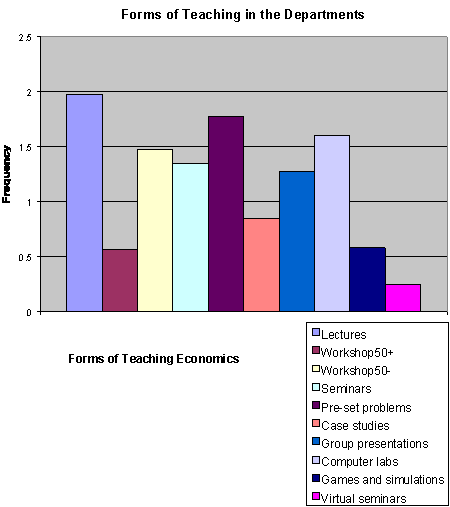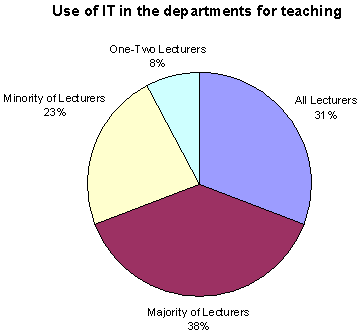Inna Pomorina
The Economics Network
Published November 2001
We conducted a departmental survey in order to get a clearer understanding of how economics is being taught in UK higher education. Of the 85 survey forms sent to our nominated contacts within each economics department we received 40 replies. We would like to thank everyone who participated in the survey.
We were interested in gathering information on four main issues:
- Departmental size and course provision;
- Learning, teaching and assessment practices;
- Use of Information technology (IT);
- Use of Economics LTSN services.
Departmental size and course provision
The survey has shown that there are more than 22,800 students in the 40 departments that responded. There were approximately the same number of small departments (fewer than 200 students) as large departments (more than 1000 students) with an average of 570 in each. From those, on average, 160 students study for a Single Honours Degree, 130 for a Joint Honours Degree and 280 took Economics as part of another degree. The departments on average provide 37 modules. Only two departments have distance-learning students and the proportion of students studying part time is very low, less than 5%.
Learning, teaching and assessment practices
Perhaps not surprisingly lectures are the most frequently used teaching practice in all but one department (the average is 1.975, where 2 is frequently used, 1 is occasionally used and 0 not used).

The survey did not investigate the reasons behind the trends and, in particular, why traditional forms of teaching continue to pre-dominate. Lecturers may have doubts in the efficiency of newer teaching methods, may be unaware of their benefits, or may be not confident enough to use them.
All of the departments surveyed use unseen exams as summative assessment. Nearly every department uses individual projects/dissertations (97.5%) and essays (92.5%). Also very popular are are multiple-choice tests (77.5%) and short answer tests (70%), group projects/presentations (75%) and individual presentation (70%). About half of the departments used problem sets in the students own time (52.5%) and computer-based tests (45%). Slightly less common are seminar contributions (42.5%), open-book exams (32.5%), previously seen exams (25%), vivas (22.5%) and peer assessment (27.5%).
Essays/seminar papers (75%) and problem sets/short questions (76.9%) are both commonly used for formative assessment purposes. Interestingly in some departments no formative assessment was conducted.
All of the departments used student questionnaires as the main type of evaluation of teaching practices. Other common methods include observation and review by peers (80%), as well as end of module review session (65%) and evaluation as part of staff appraisal (62.5%). Observation and review by managers is only used rarely (17.5%), as well as e-mail responses (25%).
We included two open-ended questions in our survey. The first one concerned the most pressing learning, teaching and assessment issues in each department. The responses identify dealing with QAA, maintaining teaching quality with escalating numbers of students and fixed staff numbers, dealing with plagiarism, coping with students of mixed abilities and devising strategies to cope with poor mathematics and English standards as recurrent themes.
Use of Information technology (IT)

The survey indicated that IT is commonly used in the teaching process although it seems to be used more often for support activities, like information access and communication with colleagues and students. It is used directly for teaching students in only 17% of departments. A networked course management system is used in 35% of the departments, with WebCT and Blackboard the most popular and First Class used only by two departments. Some of the departments not yet using any of these systems are committed to using them in the future.
Use of Economics LTSN services
The last questions were on the use of Economics LTSN services. More than 50% of the departments surveyed have already used or are immediately planning to use our services. The following workshops proved to be the most popular (with 1 showing the highest interest in attending): Promoting active learning in lectures and seminars (1.62); Computer based teaching tools (2.36); methods of student assessment (2.44); PBL (2.66); computer based economics programs (3.08); transferable skills (3.70). The least popular workshop was the use of case studies.
The second open-ended question in our survey was dedicated to the usefulness of different parts of our Web site. In general respondants find all parts of our site useful. The sections singled out for specific praise include the resource links, case studies and advice sheets from other academics, the Internet Economist tutorial and the recently launched textbook guide. Only two of the survey respondents claimed never to have seen the Web site and the same number reported to be too busy to read it very often. Some of you expressed the belief that the sites usefulness will grow in the future. We hope so too.
We are planning to use information received from this survey to shape the services we provide to the HE economics community.
↑ Top
